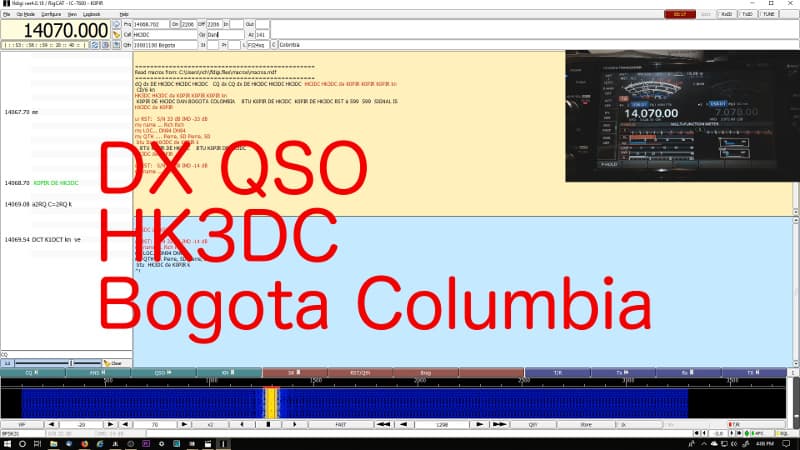Fldigi
Version 4.1.18 - Fri Jan 29 05: -0600 WF fft controls. Restore averaging, fft pre filter, latency controls Debug text. add millisecond timing to debug time stamp flarq build. fix broken build for./configure -disable-fldigi -enable-debug Exit processing. Set PTT off if user elects to close fldigi with PTT enabled. Fldigi (fldigi.exe). Fldigi is a software solution that provides users the means to transform their computer into a radio station. Equipped with digital modes, such as CW, PSK, MFSK, Hell, or Throb, it helps technology enthusiasts to calibrate a sound card to a time signal and do measurements of frequencies. Please send all trouble reports to feedback@w1hkj.com Mentor assistance is available on the following online groups:. linuxham - primarily for Linux and OS X users - groups.io. nbems - support for using the entire suite in an EMCOMM environment all operating systems - groups.io. win-fldigi - Windows users - Yahoo.com. For example, set the path to wherever your FLdigi executable is on your computer. Also, set the default FLDigi mode to what you want. In mine, the line “DEFAULTMODEM=PSK250R/1300” sets it to start FLDigi’s robust version of PSK-250 at 1300-hz waterfall frequency.
- Fldigi Vs Hrd
- Fldigi 4.1.18 Download
- Fldigi Tutorial
- Fldigi Rig Control
- Fldigi Software
- Fldigi Download Mac
We use:
1) Softrock v 6.2 with Asus Xonar U7 (192kHz -24bit) on 7 MHz band
2) RTL2832 receiver with upconverter by Makis SV1AFN
3) RLT2832 receiver on 144 MHz with omnidirectional antenna
Now > 2 MHz are available on 20 - 19 m band, please use ZOOM function on waterfall to see the signals
Sysop: Errico - IK8YSW
This server hosts also a WSPR receiver on 40 m band (7038.60 kHz) for propagation monitor.To see the received stations on the map go to http://wsprnet.org and select 40m band
More information about the WebSDR project can be found on http://www.websdr.org.
Credits and thanks to Pieter PA3FWM, author of this software
Powered by Linux Mageia 4.1 x86_64 ---- Websdr 64 bit version running
You can use also RTTY - PSK31 - JT65 decoders as HRD - Fldigi or others software to read digital modes via loopback audio interface
Note: you need both Java and JavaScript enabled for this page to work properly. If you don't hear anything, probably Java is disabled or its version is too old (i.e., pre-1.4.2).
Since Java version 7u51, Java needs to be enabled separately for each website; see http://websdr.org/java.html for instructions.
? kHz @ -6dB; ? kHz @ -60dB.
Or drag the passband edges on the frequency scale.
| Or use scroll wheel and dragging on waterfall. |
| Speed: Size: View: |
Fldigi Vs Hrd
 mute squelch autonotch
mute squelch autonotch Volume:
Fldigi 4.1.18 Download
Signal strength plot:View the last 20 lines of the logbook, or the entire logbook (ctrl-click for new tab/window).
Fldigi Tutorial
Chatbox:
This chatbox is intended to discuss the operation of the WebSDR.
The operators of this site disclaim any responsibility for text appearing in this chatbox.
Fldigi Rig Control
Visitor Tracker
Log4OM is integrated with JTAlert, PSTRotator, FLDigi, JTDX, WSJT-x, N1MM, JTAlert and QARTest. Basically every application that can work over UDP can talk with Log4OM
Log4OM features a very powerful open integration engine with which the user can create an unlimited number of UDP inbound connections to accept messages from ADIF, JTDX/WSJT-X, N1MM, QARTEST using an unlimited number of ports simultaneously.
As example Log4OM can receive UDP ADIFmessages from 10 different ports into a single Log4OM instance and so combinethe QSO’s from several radio operators possibly working in a FT8 contest into acommon logbook.
Log4OM can be configured to send ADIF messages toother application so the inbound messages above could be forwarded to perhapsan on line logbook like Clublog.
UDP PROXY will enable you to work with unique UDP messages. If two or more applications need to read a UDP message, only one of them will receive it, Log4OM is able to receive a UDP (if it’s the only listener on that port), use it and rebroadcast the incoming message over a different port, allowing other applications to use the same information.
REMOTE CONTROL will allow you to control Log4OM from another application through UDPusing the exchange protocol implemented by Log4OM.
Log4OM is also able to monitor an unlimited numberof ADIF files for changes, both on local area disks and over the internet on awebsite, it can also add logged QSO’s toa ADIF file.
Log4OM is also able to send complete POST messagesof every QSO registered (directly saved, received from external sources via UDPor read from by ADIF file monitor) to an external site, allowing the user toupload to an external service or personal online log.
Data can be provided and overlaid with static and dynamicparameters, allowing the user to add a password and other relevant informationinto the data message.
How to use it?
Fldigi Software
A remote radio station is shared by a couple offriends, both running Log4OM.
There is a simple online webpage that receives aPOST from the station including some extra parameters and it will save a TEXTfile with the ADIF data string received. Its configured to provide call signand ADIF data of the QSO saved.
Fldigi Download Mac
Once at home, the local Log4OM instance, which is configuredto monitor a remote ADIF file, will automatically retrieve the ADIF containingthe QSO’s made while operating the remote station. No paper, no USB keys, noADIF exports, everything is managed by Log4OM. A simple PHP file that does thatis included in Log4OM user manual appendix.
